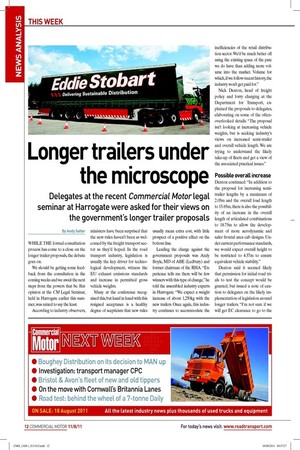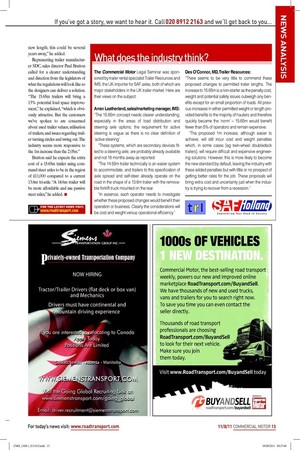Longer trailers under the microscope
Page 10

Page 11

If you've noticed an error in this article please click here to report it so we can fix it.
Delegates at the recent Commercial Motor legal seminar at Harrogate were asked for their views on the government’s longer trailer proposals
By Andy Salter WHILE THE formal consultation process has come to a close on the longer trailer proposals, the debate goes on.
We should be getting some feedback from the consultation in the coming weeks and we await the next steps from the powers that be. But opinion at the CM Legal Seminar, held in Harrogate earlier this summer, was mixed to say the least.
According to industry observers, ministers have been surprised that the new rules haven’t been as welcomed by the freight transport sector as they’d hoped. In the road transport industry, legislation is usually the key driver for technological development, witness the EU exhaust emissions standards and increase in permitted gross vehicle weights.
Many at the conference recognised this, but hand in hand with this resigned acceptance is a healthy degree of scepticism that new rules usually mean extra cost, with little prospect of a positive effect on the bottom line.
Leading the charge against the government proposals was Andy Boyle, MD of ABE (Ledbury) and former chairman of the RHA. “Experience tells me there will be few winners with this type of change,” he told the assembled industry experts in Harrogate. “We expect a weight increase of about 1,250kg with the new trailers. Once again, this industry continues to accommodate the ineficiencies of the retail distribution sector. We’d be much better off using the existing space of the parc we do have than adding more volume into the market. Volume for which, if we follow recent history, the industry won’t get paid for.” Nick Denton, head of freight policy and lorry charging at the Department for Transport, explained the proposals to delegates, elaborating on some of the oftenoverlooked details. “The proposal isn’t looking at increasing vehicle weights, but is seeking industry’s views on increased semi-trailer and overall vehicle length. We are trying to understand the likely take-up of leets and get a view of the associated practical issues.”
Possible overall increase
Denton continued: “In addition to the proposal for increasing semitrailer lengths by a maximum of 2.05m and the overall load length to 15.65m, there is also the possibility of an increase in the overall length of articulated combinations to 18.75m to allow the development of more aerodynamic and safer frontal area cab designs. Under current performance standards, we would expect overall height to be restricted to 4.57m to ensure equivalent vehicle stability.” Denton said it seemed likely that permission for initial road trials to test the concept would be granted, but issued a note of caution to delegates on the likely implementation of legislation around longer trailers. “I’m not sure if we will get EC clearance to go to the new length; this could be several years away,” he added.
Representing trailer manufacturer SDC, sales director Paul Bratton called for a clearer understanding and direction from the legislators of what the regulations will look like so the designers can deliver a solution. “The 15.65m trailers will bring a 13% potential load space improvement,” he explained, “which is obviously attractive. But the customers we’ve spoken to are concerned about used trailer values; utilisation of trailers; and issues regarding trailer turning circles and swing out. The industry seems more responsive to the 1m increase than the 2.05m.” Bratton said he expects the extra cost of a 15.65m trailer using command steer axles to be in the region of £11,000 compared to a current 13.6m tri-axle. “A 14.6m trailer will be more affordable and use passive steer axles,” he added. ■
What does the industry think?
The Commercial Motor Legal Seminar was sponsored by trailer rental specialist Trailer Resources and IMS, the UK importer for SAF axles, both of which are major stakeholders in the UK trailer market. Here are their views on the subject: Arran Leatherland, sales/marketing manager, IMS: “The 15.65m concept needs clearer understanding, especially in the areas of load distribution and steering axle options; the requirement for active steering is vague as there is no clear definition of ‘active steering’.
“These systems, which are secondary devices fitted to a steering axle, are probably already available and not 18 months away as reported.
“The 14.55m trailer technically is an easier system to accommodate, and trailers to this specification of axle spread and self-steer already operate on the road in the shape of a 13.6m trailer with the removable forklift truck mounted on the rear.
“In essence, each operator needs to investigate whether these proposed changes would benefit their operation or business. Clearly the considerations will be cost and weight versus operational efficiency.” Des O’Connor, MD, Trailer Resources: “There seems to be very little to commend these proposed changes to permitted trailer lengths. The increase to 15.65m is a non-starter as the penalty cost, weight and potential safety issues outweigh any benefits except for an small proportion of loads. All previous increases in either permitted weight or length provided benefits to the majority of hauliers and therefore quickly became the ‘norm’ – 15.65m would benefit fewer than 5% of operators and remain expensive.
“The proposed 1m increase, although easier to achieve, will still incur cost and weight penalties which, in some cases [eg twin-wheel doubledeck trailers], will require difficult and expensive engineering solutions. However, this is more likely to become the new standard by default, leaving the industry with these added penalties but with little or no prospect of getting better rates for the job. These proposals will bring extra cost and uncertainty just when the industry is trying to recover from a recession.”














































